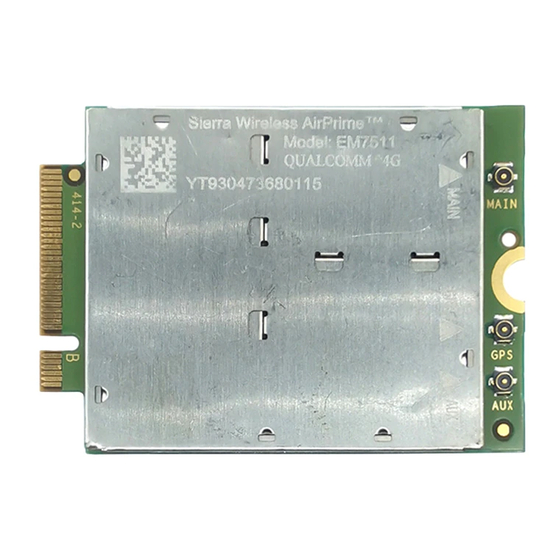
Summary of Contents for Sierra Wireless AirPrime EM7511
- Page 1 AirPrime EM7511 Hardware Integration Guide 41112332 Rev 1 Proprietary and Confidential Contents subject to change...
- Page 2 Data may be delayed, corrupted (i.e., have errors) or be totally lost. Although significant delays or losses of data are rare when wireless devices such as the Sierra Wireless modem are used in a normal manner with a well-constructed network, the Sierra Wireless modem should not be used in...
- Page 3 This product may contain technology developed by or for Sierra Wireless Inc. This product includes technology licensed from QUALCOMM®. This product is manufactured or sold by Sierra Wireless Inc. or its affiliates under one or more patents licensed from MMP Portfolio Licensing.
-
Page 4: Table Of Contents
Contents Introduction .............5 Accessories . -
Page 5: Introduction
1: Introduction The Sierra Wireless EM7511 Embedded Module is an M.2 module that provides LTE, UMTS, and GNSS connectivity for notebook, ultrabook, tablet computers, and M2M applications over several radio frequency bands. Accessories A hardware development kit is available for AirPrime M.2 modules. The kit contains hardware components for evaluating and developing with the module, including: •... -
Page 6: Power
2: Power Power Supply The host provides power to the EM7511 through multiple power and ground pins. The host must provide safe and continuous power (via battery or a regulated power supply) at all times; the module does not have an independent power supply, or protection circuits to guard against electrical issues. - Page 7 Power Table 2-1: Module Power States (Continued) State Details • Host keeps module powered off by asserting Full_Card_Power_Off# (signal pulled low or left floating) • Module draws minimal current Disconnected • Host power source is disconnected from the module and all voltages associated with the ...
-
Page 8: Rf Specifications
3: RF Specifications The EM7511 operates on the frequency bands listed below. Table 3-1: LTE Frequency Band Support Band Frequency (Tx) Frequency (Rx) 1920–1980 MHz 2110–2170 MHz 1850–1910 MHz 1930–1990 MHz 1710–1785 1805–1880 MHz 1710–1755 2110–2155 MHz 824–849 MHz 869–894 MHz 2500–2570 MHz 2620–2690 MHz 880–915 MHz... -
Page 9: Rf Connections
RF Specifications Table 3-2: WCDMA Frequency Band Support Frequency (Tx) Frequency (Rx) Band Band 1 1920–1980 MHz 2110–2170 MHz Band 2 1850–1910 MHz 1930–1990 MHz Band 4 1710–1755 MHz 2110–2155 MHz Band 5 824–849 MHz 869–894 MHz Band 6 830–840 MHz 875–885 MHz Band 8 880–915 MHz... -
Page 10: Antenna And Cabling
Product Technical Specification Antenna and Cabling When selecting the antenna and cable, it is critical to RF performance to match antenna gain and cable loss. Choosing the Correct Antenna and Cabling When matching antennas and cabling: • The antenna (and associated circuitry) should have a nominal impedance of 50 ... -
Page 11: Ground Connection
RF Specifications Ground Connection When connecting the module to system ground: • Prevent noise leakage by establishing a very good ground connection to the module through the host connector. • Connect to system ground using the module’s mounting hole. • Minimize ground noise leakage into the RF. -
Page 12: Device-Generated Rf Interference
Product Technical Specification Proximity of host electronics to the antenna in wireless devices can contribute to decreased Rx performance. Components that are most likely to cause this include: • Microprocessor and memory • Display panel and display drivers • Switching-mode power supplies Device-generated RF Interference The module can cause interference with other devices. - Page 13 To determine the extent of any receiver performance desensitization due to self- generated noise in the host device, over-the-air (OTA) or radiated testing is required. This testing can be performed by Sierra Wireless or you can use your own OTA test chamber for in-house testing.
-
Page 14: Regulatory Compliance And Industry Certifications
Although significant delays or losses of data are rare when wireless devices such as the Sierra Wireless module are used in a normal manner with a well- constructed network, the Sierra Wireless module should not be used in situations... -
Page 15: Important Compliance Information For United States And Canada
Regulatory Compliance and Industry Certifications In an aircraft, the EM7511 module MUST BE POWERED OFF. Otherwise, the EM7511 module can transmit signals that could interfere with various onboard systems and may be dangerous to the operation of the aircraft or disrupt the cellular network. - Page 16 Mobile carriers often have limits on total radiated power (TRP), which requires an efficient antenna. The end product with an embedded module must output sufficient power to meet the TRP requirement but not too much to exceed FCC/IC's EIRP limit. If you need assistance in meeting this requirement, please contact Sierra Wireless. Rev Apr.18...
- Page 17 Regulatory Compliance and Industry Certifications 4. A label must be affixed to the outside of the end product into which the EM7511 module is incorporated, with a statement similar to the following: · This device contains FCC ID: N7NEM75S Contains transmitter module IC: 2417C-EM75S where 2417C-EM75S is the module’s certification number.
-
Page 18: Acronyms
A: Acronyms Table A-1: Acronyms and Definitions Acronym or term Definition 3GPP 3rd Generation Partnership Project BeiDou BeiDou Navigation Satellite System A Chinese system that uses a series of satellites in geostationary and middle earth orbits to provide navigational data. Bit Error Rate—A measure of receive sensitivity BLER Block Error Rate... - Page 19 Acronyms Table A-1: Acronyms and Definitions (Continued) Acronym or term Definition Hertz = 1 cycle/second Industry Canada Intermediate Frequency Interim Standard. After receiving industry consensus, the TIA forwards the standard to ANSI for approval. Long Term Evolution—a high-performance air interface for cellular mobile communication systems.











Need help?
Do you have a question about the AirPrime EM7511 and is the answer not in the manual?
Questions and answers